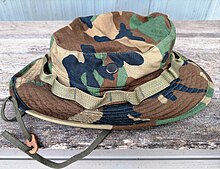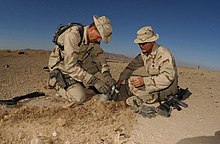Boonie hat
This article needs additional citations for verification. (January 2022) |

A boonie hat or booney hat is a type of wide-brim sun hat commonly used by military forces in hot tropical climates. Its design is similar to a bucket hat but with a stiffer brim.
The Australian giggle hat has a thinner brim. Often a fabric tape band of "branch loops" is sewn around the crown of the hat. This "foliage ring" is meant to hold additional vegetation as camouflage. A strap provides stability. The crown may be vented with eyelets or small mesh panels. Snaps may also be provided with which to fix the brim in the style of an Australian bush hat.
U.S. military boonie hat

A blue cap with an all-around brim was issued as part of the 1937 blue denim fatigue uniform that was nicknamed the "
The boonie hat was introduced to the
In 1967, the U.S. Army began issuing boonie hats, such as the "Hat, Jungle, with Insect Net", made of
Hat, Camouflage (Tropical Combat) Type II
In 1968 the U.S. Army authorized the use of the woodland ERDL pattern (
Hat, Sun, Hot Weather
Later boonies are called "Hat, Sun" or "Hat, Sun, Hot Weather", which is still the designation for this type of cover. They are made in various patterns, in cotton ripstop or nylon blend cloth.[4]
Australian Army giggle hat

Similar wide-brimmed hats in the
The giggle hat gained popularity during the Malayan Emergency. Protection from the searing heat of Malayan conditions and heavy rain proved to be necessary. Alongside the British, the Australian Army started issuing this type of hat, which had a steeper and shorter brim than its earlier counterparts. It was made with the same materials as the hot weather combat uniforms, unlike the slouch hat, which was beginning to take on a more ceremonial role rather than being field gear.
These hats gained popularity during the

Current giggle hats are issued in Multicam Pattern. They continue to be heavily used by the Australian Defence Force, and are issued to every person serving in the Australian Army and Royal Australian Air Force (RAAF).
See also
- Panamanka
- Bucket hat
- Patrol cap
- Side cap
- Peaked cap
- PASGT
- ACUPAT
- Pith helmet
- Slouch hat
References
- ^ p. 11 Young, Edward M. Merrill’s Marauders Osprey Publishing Ltd. 2009
- ^ . p. 81 Lemons, Charles Uniforms of the U.S. Army Ground Forces 1939 – 1945 Volume 5 Part 1 Caps and Hats Lulu.com, 13 May 2016[self-published source]
- ^ "The Johnny Jeep Hat: The Army fatigue hat inspires a new fashion fad". Life. 24 August 1942. pp. 104–105. Retrieved 29 June 2018.
- ^ a b c d Hat, Jungle (Boonie)
- ISBN 978-1-134-19478-0.
- ISBN 0-226-10949-6.
- ISBN 0-8078-5653-3.
- ISBN 0-7102-0006-4.
- ^ "Vietnam - Equipment and Uniform". david.brubakers.us.
- ^ Cyril Ray (2001). "Jungle Chic". Australian Government Department of Veterans' Affairs. Retrieved November 13, 2014.
